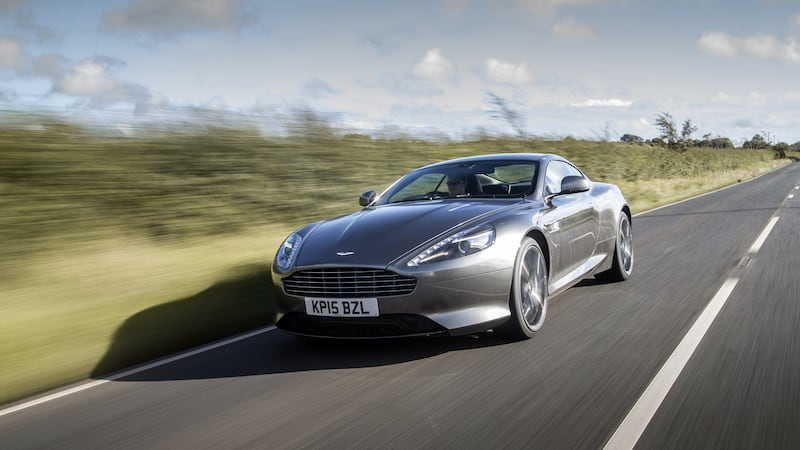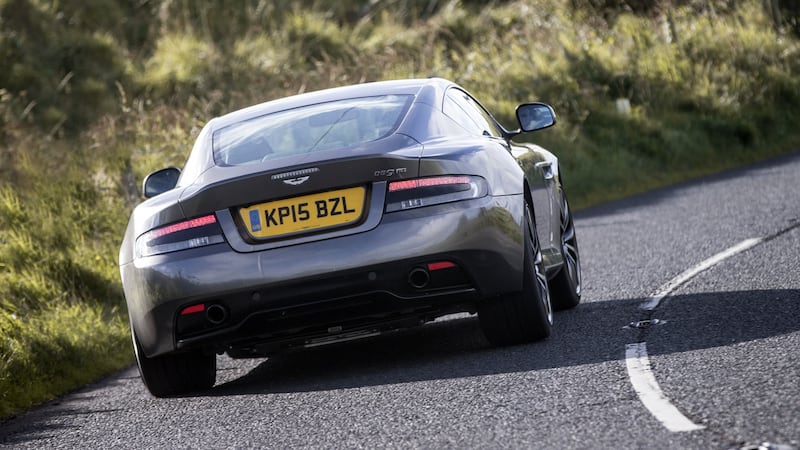It was the first truly modern Aston Martin. The sports car maker, famous for its swooping designs, its barking engine notes and its intimate association with the Secret Service (even if real intelligence officers are more likely to be found behind the wheel of a plain-wrapper Mondeo or Insignia) had leapt ahead of many of its rivals in the 1960s.
Backed by tractor money, under the ownership of agricultural machinery magnate David Brown, the classic DB4, 5 and 6 models wrapped delicious Italian bodies (styled by Touring of Milan), wrought in lightweight aluminium over spaceframe chassis powered by lusty six-cylinder engines.
They were cinematically sexy but barely profitable, and their lack of black ink led Aston to lurch from crisis to crisis until, at last, it was bought by Ford in the 1980s.


With coffers stacked up with Detroit cash, Aston finally started to modernise. A new V12 engine was designed and built, a new aluminium chassis was engineered and, at last in 2004, Aston launched the DB9 – its first truly cutting-edge car. Light of weight and stunning of line, it set a template from which Aston has barely deviated this past decade.
It brought unheard-of success to a brand which had never before broken into four-figure production schedules. In 2004, Aston Martin built 700-odd cars. In 2005, it made 1,200, almost all of which were DB9s.
And this is the last. The DB9 GT is Aston’s idea of a run-out edition. Forget free floor-mats and a leather steering wheel, this one gets three-stage adaptive dampers, a new Garmin-designed infotainment system, mildly massaged styling and, most crucially of all, an upgrade to the 6.0-litre V12 engine bringing it to a towering 547hp.
You would think such a colossal power output would utterly dominate proceedings, but oddly it doesn’t. Select Sport mode to sharpen the throttle response, firm up the chassis and open a couple of critical valves in the exhaust, and the DB9 roars and growls like a Bengal tiger with a two-day hangover.
It makes as much noise as it does power, and both are pretty intoxicating. Going from 0-100kmh in 4½ seconds is not actually that fast, but it’s the way the DB9 accelerates that really grabs your attention. The rear-mounted automatic gearbox effortlessly firing new ratios at the engine’s behest.
Quality levels
Many cars that can do blistering 0-100kmh runs feel breathless much past that figure but the DB9 just keeps on going, up to a maximum of 300kmh if you have the space, courage and legal permissions.
All of that accompanied by a symphony of cylinders that makes the Vienna Philharmonic sound like it's playing all the wrong notes (and not necessarily in the right order).
Practical? Hardly. The back seats are tiny to the point of ridicule and even in the front, if you are tall, you’ll find the front seats are set too high. Quality levels are excellent (Aston takes about 200 hours to effectively handbuild each car, so it should be) but there is the occasional cheap fixture or fitting, and the main dials are still fiddly and difficult to read.
And to drive? Well, in some ways it’s brilliant. The new adaptive dampers really help; sharpening up body control without bringing in a crippling ride quality. The DB9 feels alive and responsive to the throttle and steering in a way that you would have thought modern legislation and electronics would simply not allow. It also has titanically capable brakes (they’re carbon-ceramic as standard), but on Irish tarmac it does feel a little fidgety and occasionally nervous. Wet roads also do a lot to remind you just how much power you’re trying to stuff through the rear wheels.
A Bentley Continental GT, by comparison, is not half so much fun to drive when you're in the right mood, but far more sure-footed and idiot-proof when you're not.
Beguilingly beautiful
It would be hard to argue with the DB9’s looks. Car years are like dog years, so at 11 years old, the DB9 is well past its bus pass, yet it looks as fresh-faced and beguilingly beautiful as
Audrey Hepburn
peering out from a
Breakfast At Tiffany’s
poster. Timeless and there’s not a bad angle on it.
Aston says that even though the car's replacement (badged DB11, as the DB10 is a strict ten-off special built only to be used in the new James Bond film) has been announced, DB9 customers are still coming in, saying that they want just one more, so enamoured are they of the car.
Are many of them Irish? Not too many: fewer than 50 DB9s have been sold in Ireland since the car was launched, but Derry-born Dermot Harkin, recently appointed Aston's UK regional manager and who also oversees the Irish operations, told me: "We have a very active Aston Martin owners' club in Ireland, and the enthusiasm for the brand and the products is very much there. It's never going to be huge numbers obviously, but we would hope to pull in a few more customers over the next few years."
Renovated premises
There’s no chance, for now, of a dealership for the Republic: Aston’s operations in Ireland are handled by Belfast-based
Charles Hurst
, which has just opened a renovated premises on the Boucher Road.
Harkin told me that Aston feels that, for now, it can offer Irish customers great service by sending staff to them, but that if a dealership for the 26 counties was to be given a go, Hurst’s would get first refusal on the idea.
It would be nice to think that a car as gorgeous as the DB9 might become a more familiar sight on Irish roads, as the recession fades away. It will probably remain rather more rare than that, but perhaps something so lovely should never be allowed to become commonplace. Lowdown: Aston Martin DB9 GT Price: €280,000 (approx)
Power: 547hp
Torque: 620Nm
0-100kmh: 4.5sec
Top speed: 300km/h
Claimed economy: 14.3l/100km (19.7mpg)
CO2 emissions: 333g/km
Motor tax: €2,350











